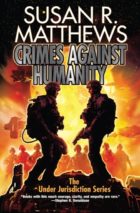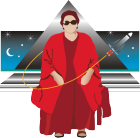Firstborn and Eldest
Introduction
Once you turn in your manuscript to your editor, she does her Editorial Revision letter; then she gets it back, and assuming all has gone well with your Editorial Revision, it goes to copy-edit at that point.
Now, on Angel of Destruction, one of the questions that the copy-editors (a team, in this instance) asked about continuity sparked me off on a meditation about the exact forms of the language that Dolgorukij use amongst themselves. The question the copy-editors asked resulted in the addition of meaning and depth to the manuscript — maybe it wasn’t obvious, and with luck it wasn’t, but it was there. I was enormously chuffed by the whole thing.
Here is a narrative summary of the analysis I had to do in response to the copy-editor’s question about continuity. I hope you get a chuckle out of it. It gave me another way to express shades of meaning in discourse and I got a tremendous charge out of it.
Here’s health and prosperity to all copy-editors, who make the book better and get no credit for it (grin).
The Text
First-Born and Eldest
Shades of Meaning in Word-Order in Forms of Address
The language used by religious professionals amongst themselves preserves some very old forms of discourse in Dolgorukij, and it may be instructive to examine the permutations of the terms in which Fisner Feraltz and Dalmoss address each other.
The expanded version of the phrase that Dalmoss uses to address Feraltz, “firstborn and eldest,” is actually “firstborn child and eldest son” (or eldest son and firstborn child, when he says “eldest and firstborn”).
“Firstborn child and eldest son” is as senior as you can get in Dolgorukij. “Eldest” is almost never expanded to “eldest son,” “son” being understood; but in the odd case when it is used to refer to a woman it is always expanded to “firstborn child and eldest daughter.”
The best thing to be is “firstborn and eldest,” since “eldest and firstborn” contains the hint that one might be the eldest son but not the firstborn child, a hint that persists past the assertion of “firstborn child” in the minds of people like Dolgorukij to diminish the authority of “firstborn son” just a tad. There are subtle factors of primacy and guilt at work here from way back in Combine cultural history. Dalmoss addresses Fisner as “firstborn and eldest” except in scenes in which he has reservations about Fisner’s strategy, in which case “eldest and firstborn” would be entirely appropriate.
Andrej Koscuisko is “eldest son and secondborn child,” which means in turn that no one would ever actually call him “eldest and secondborn” unless they were insulting him by pointing out that he has an older sister whose claims on the leadership of the Koscuisko familial corporation have been discarded. It’s the sort of thing that Andrej’s brother Iosev, second eldest son and thirdborn child, might say. Iosev’s got an attitude problem.
So much for sociology.
With this in mind it becomes obvious that the most correct version of the corresponding form for Fisner to use to address Dalmoss is “next born and second eldest,” next born child and second eldest son, which is as much respect as one can extend to a subordinate. As “eldest and first born” is a subtle put-down that carries a very shadowy hint that one is not the oldest child, “next born and second eldest” carries the whisp of an implication that one might be the eldest son (if the first born happened to have been daughter); and is therefore the nicest thing the firstborn and eldest can say to a person. When Fisner wishes to rebuke Dalmoss or remind Dalmoss of Fisner’s authority he uses “second eldest and next born,” which carries the implication (as above) that Dalmoss could have seven sisters older than he is, reducing his rank in the ancestral procession accordingly.
That’s my story, and I’m sticking to it. My thanks to my copy-editors for focusing my attention on this interesting bit of trivia about polite discourse amongst the wild Dolgorukij.

